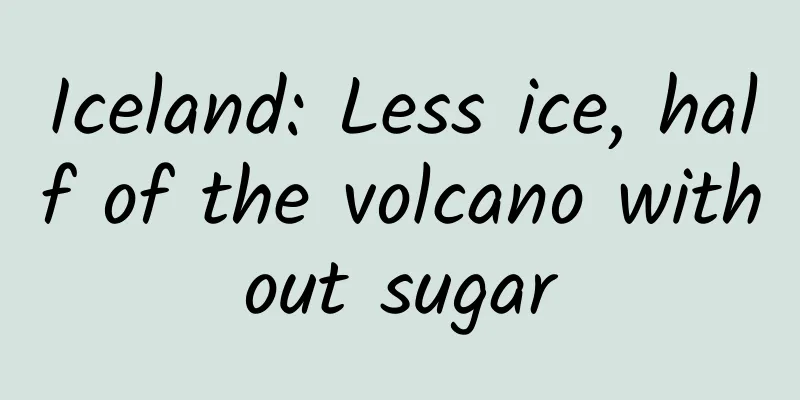Iceland: Less ice, half of the volcano without sugar

|
The other side of Eurasia In the cold wind of the Arctic Circle On the raging waves of the North Atlantic There is The country known as "the end of the world" Iceland (Kirkjufell, Iceland's iconic natural scenery, named after its straw hat shape, photographer @高承) ▼ Between Heaven and Earth The deserted wasteland As if forgotten by time (Please watch Vestrahorn in landscape mode under the aurora. It is named after its shape that resembles a bat with wings spread. Photographer: He Jinyi) ▼ The world is prosperous It's none of my business (Please view the canyon in Þórsmörk Nature Reserve in horizontal mode, image source: Visual China) ▼ Worldly Trouble It's none of my business (Reynisfjara Black Sand Beach, photo courtesy @Business Iceland) ▼ But in the most desolate land But the world was born One of the most desirable countries for travelers It is located in the Arctic Circle The average temperature in the coldest month of winter is no less than -3°C Warmer than many places at the same latitude (The sun shines directly into the ice cave, as if it is setting the ice on fire; in comparison with my country, the average temperature in the coldest month in Northeast China is maintained at -2℃ to -25℃. Image source: @Visual China) ▼ It's away from the world But it has a per capita GDP of $68,000 Rated by the United Nations One of the countries with the highest human development index in the world (Reykjavik, the capital of Iceland. In the past five years, Iceland has always ranked in the top three in the Human Development Index. Photographer @璋视觉) ▼ Iceland What kind of country is it? (Iceland's geographical location. The straight-line flight distance between Iceland and Beijing is about 7,800 kilometers. Map by @Song Nan/Planet Research Institute) ▼ 01 Flaming Glacier Iceland It was once a mysterious legend in Europe 9th century AD According to legend, someone was in distress at sea. Accidentally drifted to an uninhabited island There is snow and wind and the climate is extremely cold. The land is frozen Later generations called it "Iceland" (Vatnajökull Glacier, the filming location of the "Ice Planet" in Interstellar, image source: @Visual China) ▼ However Iceland is more than just an island Below it are overlapping peaks. Undersea Mountains (Illustration of Iceland's submarine topography. The submarine mountain range extends from the Arctic Ocean to the southern tip of Africa, about 16,000 kilometers long, which is the "Mid-Atlantic Ridge". Map by @Song Nan/Planetary Research Institute) ▼ Tens of millions of years ago The North American and Eurasian plates are gradually separating Magma continues to rise along the cracks Until it breaks the sea Iceland Born in flames (The birth of Iceland. 25 million years ago, a giant mantle plume convected to the bottom of the plate to form a huge amount of magma, which continued to erupt with the help of the mid-ocean ridge. Map by @Du Rui & Song Nan & Li Sanlian/Planetary Research Institute) ▼ This is a violent volcanic island. 103,000 square kilometers of land area Equivalent to Jiangsu Province There are more than 30 volcanic systems across the island. Together they form the highest and most dangerous section of the island. (Display of the distribution of Icelandic volcanoes. The direction of the volcanoes is similar to that of the mid-ocean ridge, running southwest to northeast across Iceland. Map by @Song Nan/Planetary Research Institute) ▼ Iceland's largest volcano Bardarbunga 2009 meters above sea level Covering an area of 2,500 square kilometers Equivalent to the total area of Hong Kong (Eruption of Fagradalsfjall volcano on the Reykjanes Peninsula in Iceland in 2021, image source: Visual China) ▼ But born in the land of fire Also born in ice Iceland is located in the Arctic Circle The cold glaciers are another dominant force here. When Ice Meets Fire A war is bound to start (Please watch Bat Mountain in horizontal mode. The sunset illuminates the rain clouds. It's like chaos is just beginning, and the song of ice and fire is about to begin. Photographer @沈霖) ▼ Glaciers "suppress" volcanoes with their thick ice and assert their sovereignty The area is as high as 8,100 square kilometers, equivalent to half of Beijing. Vatnajokull, the largest glacier in Iceland He conquered seven volcanoes alone The average thickness of the ice is 380 meters (Vatnajökull Glacier, with its icy tongue baring its teeth, photographer @罗杰) ▼ Proud volcano Gradually, the glaciers cut into sharp edges Rugged mountains (Vatnajökull Glacier, photographer @高承) ▼ When the glacier is at its strongest Covered all of Iceland The land along the coast has also been eroded. Long narrow fjord (Kambsnes, one of the viewing points in the Westfjords, photo courtesy @Business Iceland) ▼ But the volcano Not willing to give in They are like a group of crazy gunners Through one volcanic eruption after another Breakthroughs were opened one after another on the frozen land. A large amount of molten lava from the center of the earth Surge up from the breach Rapidly swallowing glaciers The volcanic island begins to show its true strength (In August 2022, the Meradalier volcano erupted, with lava pouring out of a 300-meter-long crack. Photographer @丁亦然) ▼ Volcano, also good at surprise attacks They lurk beneath the calm sea surface Explodes suddenly when the enemy is least prepared Create a new island Expand your new territory (Heimaey Island, a volcanic eruption in 1973, which lasted for nearly half a year and formed a new volcanic cone Eldfell, which literally means "volcano" in Icelandic. Image source: Visual China) ▼ The volcano's weapon: heat The most feared glacier Thick ice melts into water Falling straight down from the top of the mountain Forming a magnificent waterfall landscape (Secret waterfall in spring and summer/Gljufrabui, photographer @刘白&李永男风景旅游摄影) ▼ Glacial meltwater falls from the volcanic territory Along the terrain, it flows into rivers on hillsides and plains Forming a dense water network (The stream flows on the plain like an autumn "braid", photographer @Su Tie) ▼ Others Together with atmospheric precipitation A lake formed in the crater (Crater Lake in southeast Iceland, photographer @Henry Liu) ▼ So far The Game of Flames and Ice Gradually reaching a delicate balance Left a magnificent mark in Iceland: ice Ice Ice Ice Ice ice ice ice volcano volcano volcano (Please view Snæfellsjökull in horizontal mode, a typical subglacial volcano, photographer @刘白) ▼ The war of ice and fire gradually came to an end Iceland is also beginning to reveal more of its wild appearance After tens of millions of years of eruption, Unique columnar joints are formed by cooling and shrinkage (Swati Falls, the cliffs are mostly hexagonal columnar joints, photographer @贺进一) ▼ Other rocks from volcanoes Exposed on the coast After being eroded by running water, it is broken into fine black sand A rare black sand beach Let the waves hit you The Battle of Flames and Ice Finally, in the flowing water and crushed sand Towards the final chapter (Black sand beach at Cape Dyrholaey, photographer @afun阿方) ▼ but This land is so violent Is it really suitable for humans? 02 Polar Vitality 9th century AD A chieftain living on the coast of Norway Ingólfur Arnarson Exiled for killing his compatriots Nowhere in Northern Europe Only one chance Lead your confidants to sail far away Hoping to find the legendary "Iceland" As his new home (The Faroe Islands, located between the Norwegian Sea and the North Atlantic Ocean, have long been mistaken for the legendary Iceland. Image source: Visual China) ▼ 874 AD Inger landed in a "smoking bay" “Smoke” is actually water vapor There are more than 800 large hot springs scattered across this volcanic island. Hot magma heats the water Hot steam rising everywhere The Smoking Bay Reykjavik The capital of Iceland (Strokkur Geyser/Strokkur, picture source @Visual China) ▼ However Inger discovered that "Iceland" is not ice The North Atlantic Current flows northward from the Gulf of Mexico Flows through southwestern Iceland The climate along the coast is relatively warm Reykjavik even happens to be one of the warmest areas in the country (North Atlantic Ocean Currents. Iceland has a cold temperate oceanic climate, with winter temperatures ranging from 3°C to -3°C and summer temperatures ranging from 15°C to 8°C. Map by @Song Nan/Planetary Research Institute) ▼ Cold and Warm Directly determines the possibility of human survival In the larger climate context Medieval Warm Period Towering glaciers Melting water brings a lot of fresh water resources Grass and shrubs grow wildly all over the island. Vegetation coverage is over 60% (Cute creatures in Iceland: sheep, puffins, and arctic foxes, photographer @请叫我安大侠&Visual China&BusinessIceland) ▼ Yin Ge looked at the vibrant scene in front of him. Decided to settle here People cut down trees and built houses Chopping wood and burning fire for warmth And divided the vast grassland into pastures Raising sheep and cattle (Iceland's medieval turf houses are generally composed of a main house, side houses, barns, and farms. Photographer: Gao Xufei) ▼ Iceland's story gradually spread across Europe Many residents of Northern Europe, Ireland, and northern Scotland I also long for a new home without chaos Iceland is the best target They traveled across the ocean to Iceland Seize the most livable settlements (Guess where is the most livable place in Iceland? After the last ice age, Iceland's glaciers retreated and now only account for 11% of the country's land area. Map by @Song Nan/Planet Research Institute) ▼ The coastal plains have a warm climate Gentle hillsides and dense rivers People can both graze and develop farmland Growing cereals such as barley and oats (Please view Vik in the south in horizontal mode. The hillsides are suitable for grazing and the plains are suitable for farming. Image source: Visual China) ▼ The plains in the fjord area are relatively narrow But there is a winding coastline People live in the mountains and face the sea Fishing for a living (Ísafjarðarbær, photographer @罗杰) ▼ 10th to 12th century AD People gradually expanded from the coast to the inland plateau On steep mountains Sheep grazing (Jökulsá á Fjöllum, the second longest river in Iceland, a canyon formed by glacial floods, photographer @闭眼沉默) ▼ In the turbulent rift Discuss state affairs (Thingvellir, where people gathered in the summer to organize parliament since 930 AD, laying the foundation for Iceland's democratic parliamentary system. Photographer: @请叫我安大侠) ▼ In just two centuries Iceland from an uninhabited island Became a new country with tens of thousands of people However, in the 13th century A devastating natural disaster From then on, the fate of this small island was pushed in another direction. ——The Little Ice Age is coming Glaciers expand from the Arctic Circle to lower latitudes Iceland sees sharp drop in temperatures (Please view the Dyrhólaey Cape in southern Iceland in horizontal mode, which looks like a lifeless frozen land. Photographer: @吴邺霖) ▼ Plants grow slowly due to low temperatures Large areas of farmland and grassland After excessive logging and grazing Trapped in a vicious cycle of soil erosion A large number of livestock and people died in the famine (Large area of wasteland in the central highlands of Iceland, photographer @罗杰) ▼ Natural disasters occur without warning Then people realized Humans never really owned this land. Flames and Ice A heavier blow Most of Iceland's volcanoes are buried under glaciers Volcanoes melt glaciers from within Once a volcano erupts Not only triggering a series of earthquakes, landslides, mudslides It will also cause glacial lake outbursts and glacier rises. Causes massive flooding (The internal structure of the glacial flood is shown in the figure. Iceland calls this disaster "jökulhlaups". The flood further exacerbated the problem of soil erosion. Map by @Du Rui/Planetary Research Institute) ▼ Human civilization built over two centuries On the verge of extinction Iceland Where does this leave us? 03 Integrate into the world Iceland has a total area of 103,000 square kilometers However, only 3% of the land is suitable for agricultural development. Land infertility is like a chronic disease Killing people in despair (Famine was particularly frequent during the Little Ice Age, photographer @高旭飞) ▼ Fortunately, Iceland still has the ocean The island has 4,970 kilometers of coastline. Ocean currents concentrate nutrients in shallow waters Attracts a large number of fish People adapt to changes in nature Grazing in the summer when grass and trees are growing vigorously Fishing in winter during the breeding season 19th century Iceland relies on limited natural resources Survived in a self-sufficient mode (Westfjords, photographer @罗杰) ▼ However This kind of survival mode is like living on an "isolated island" The resources of this land are always too limited Iceland knows it must look further ahead Enter the world The other side of the sea There is a country as cold as Iceland - Norway Iceland sent wool, textiles, and dried fish to In exchange for food, wood, and salt (Dried fish. Icelandic Nobel laureate Laxness once lamented that the most important thing in life is dried salted fish. Image source: @Visual China) ▼ To the east, there is the United Kingdom more than 1,000 nautical miles away. Iceland ships fish oil to it for fuel The British also prefer to cook plump and tender cod. Fish, a transformation It has become Iceland's most important commodity. Fishing has since become Iceland's mainstay industry. (Whale watching scene in Husavik. From 1958 to 1976, Iceland fought three wars with Britain over cod fishing rights. Photographer: Gao Cheng) ▼ To the west, nearly 10,000 nautical miles away is the United States During World War II As the US, British and German allies competed for supremacy at sea The importance of the North Atlantic shipping route is also gradually increasing. Iceland is located at the northern end of the North Atlantic Ocean Occupying Iceland is equivalent to controlling part of the sea power. Traffic advantages gradually become more prominent (Reykjavik Domestic Airport, built by the British Army during World War II; after the British Army withdrew, the United States stationed in Iceland until 2006, and later signed an agreement to assume Iceland's military defense responsibility. Image source: @Visual China) ▼ When the “isolated island” chooses to enter the world Iceland has successfully broken out of its once self-sufficient mode Rapidly catching up with an era of globalization In this era An Icelandic fish can be exported all over the world Goods from all over the world can also be imported into Iceland (During the period of the US military stationing, a large number of roads and bridges were built, strengthening the connection between Iceland's coastal towns and the capital. Photographer @Henry Liu) ▼ But the connection with the world It also puts Iceland in a new predicament Once the world situation changes Iceland will also be affected The international oil crisis broke out in 1973 Soaring oil prices have made Iceland realize You must develop your own resources (A large truck in a snowstorm. Due to the long winter and fluctuating weather, Iceland's largest import dependence in the 20th century was fossil fuels. Photographer @璋视觉) ▼ A look at Iceland The Central Plateau is not a good place to live. However, abundant water flows down the hillside The height difference creates a strong water force Good for power generation (Godafoss Waterfall/Godafoss, Photographer @高承) ▼ The most dangerous volcanic belt However, there is a huge amount of heat energy hidden inside Enough to drive the generator to generate electricity Hot water can also be used for daily use Geothermal heat has greatly improved the living space of Icelanders (Illustration of geothermal use in Iceland, drawn by @Du Rui/Planet Research Institute) ▼ Hydro and Geothermal Both will not damage the land and can be recycled Bringing endless electricity to Iceland Thus becoming Iceland's most important natural resource in the 20th century then Iceland has abundant and cheap energy supply Attract multinational companies to set up factories The energy-intensive electrolytic aluminum processing industry is particularly advantageous Manufacturing, mainly based on smelting, has gradually become an emerging industry in Iceland (Svartnijmegen thermal power plant. Currently, Iceland has three aluminum smelters, producing about 800,000 tons per year. Image source: Visual China) ▼ The world is starting to take notice of the tiny country of Iceland There is potential for sustainable economic development There are also magnificent natural scenery The wasteland of the past Now it is filled with people's fantasies that have nowhere to go This could be an alien planet, the end of the world, or the end of the world. People travel across the ocean just to see this wonder Iceland's tourism industry begins to rise (Please watch the cave aurora in horizontal mode. In 2019, before the epidemic, the total number of tourists in Iceland reached 2.2 million, which is equivalent to 6 times the population of Iceland. Photographer @Su Tie) ▼ Tourism, manufacturing, and the traditional economic pillar of fisheries Together they form Iceland's three major industries Iceland succeeded in limited natural conditions Find your own economic development model (Export value of Iceland's main goods, map by @Du Rui/Planet Research Institute) ▼ now Iceland sets sights on Arctic Circle Hidden under the vast sea ice 18% of the world's oil and 30% of its natural gas Great potential for industrial and commercial development (Arctic seals. Nowadays, there are regular tour groups visiting the Arctic. Photographer: @陈彬彬) ▼ The Arctic Ocean was once frozen over However, with global warming Sea ice gradually melts A faster, shorter and more convenient route The Arctic route will soon be fully open to navigation Iceland is expected to become an important transit point (Comparison between the Eurasian route and the Arctic route. The biggest bottleneck for shipping between China and Europe is the Suez Canal. Going north through the Arctic Ocean will be a faster option. Map by @Song Nan/Planetary Research Institute) ▼ Everything seems to be going well But there is always another side to things Global warming causes large-scale melting of glaciers Iceland's sea level It is rising at a rate of 3 mm per year The ecological balance of the ocean has also begun to be affected (Grundarfjörður on the Snæfellsnes Peninsula. The most habitable coastal plain will be directly affected by the melting of glaciers. Photographer @丁亦然) ▼ Before a better future comes Iceland seems to have more crises to face future Would Iceland be better? 04 Warm and Cold World 2023 The total population of Iceland is 370,000 Of these, 240,000 people live in the capital region. The population distribution is extremely uneven (Kerlingarfjöll, a sparsely populated volcano, has become a typical Icelandic impression. Photographer: Henry Liu) ▼ 19th century onwards Iceland has developed a relatively complete welfare system Let Icelanders in their lifetime Whether facing illness, unemployment or retirement, you will be protected (Illustration of the Icelandic government's fiscal expenditure structure, with national welfare accounting for the largest proportion, drawn by @Du Rui/Planet Research Institute) ▼ But as a country with extremely frequent natural disasters There is always a limit to what Iceland can do Since its creation, this island Destined to be governed by the laws of the polar regions Because of its location in the Arctic Circle Every year after the autumnal equinox Iceland's days are getting shorter Instead, long winter nights (Please watch the double moon rainbow, aurora, and Big Dipper lighting up the night sky of Iceland in horizontal mode. Photographer: @苏铁) ▼ Contrary After the Spring Equinox Iceland's days are gradually getting longer than its nights There are several days in June with sunshine lasting up to 21 hours Even at midnight the sun was still shining (Golden Waterfall/Gullfoss in the midnight sun, photographer @李永男风景旅游摄影) ▼ Life in Iceland Like wandering between light and shadow Iceland during the day in December Only 4 and a half hours Now, in March Days start to get longer in Iceland 9 a.m. The east is illuminated by the sun first (A small house under the snowy mountain of Stapafell in southern Iceland, photographer @刘白) ▼ 11 a.m. It's a busy time From late January to May every year Fish follow the ocean currents to the south coast to spawn Swim further west The laws of nature run through the ages Life in Iceland goes on as usual (Akureyri, the largest city in northern Iceland, photographer @张明琛) ▼ 12 noon Maybe there will be a snowstorm. Children happily playing in the snow (The weather in Iceland is unpredictable, blizzards, rain and cloudy weather are commonplace, photographer @丁亦然) ▼ Sunny at 2pm Changing weather makes people more aware of the present moment Travelers like to drive around the island during this time. Soak in hot springs and visit ice caves Enjoy the sunshine (Ice cave in Iceland, photographer @李永男风景旅游摄影) ▼ 4 p.m. The towering cliffs are undisturbed Iceland will save large areas of vulnerable land Designated as a nature reserve Let everything grow freely (Please view the Straw Hat Mountain in horizontal mode under the colorful clouds. It is part of the Snæfellsjökull National Park. Photographer: @郭家豪) ▼ 5pm People go home from get off work When work ends, life begins The streets and shops gradually became lively. The restaurant also began to make noisy noises. (Street view of Reykjavik, the tower-like building in the distance is Hallgrímskirkja Cathedral, picture source: Visual China) ▼ The night comes quickly Iceland’s “night life” also comes early 8 p.m. Whether it is a dinner party, a bar, or a concert Or stay at home Icelanders have long winter nights to spend their leisure time (Christmas in Reykjavik, picture source: @Visual China) ▼ The city is bustling The distant central mountains have long been silent. 10 o'clock at night Only the sound of running water is left (Skógafoss, photographer @刘白) ▼ Midnight People turned off the lights one by one When Iceland falls into darkness again A heavenly light is lighting up the night sky Solar wind "blowing" from 150 million kilometers away The Earth's magnetic field leads to the North and South Poles The collision with the atmosphere produced the aurora. That instant flash of light Perhaps as every Icelander can have The moment (Aurora "Dancing of the Gods", photographer @Su Tie) ▼ This article was created by Written by : Chagall Editor : Director Image : Long Shijie Design : Du Rui & Li Sanlian Map : Songnan Proofreading : Yunwukongcheng & Qingliu & Wu Xintian Cover Photographer : Gao Cheng & Zhang Mingchen Audit Expert Professor Chen Liang, Research Fellow at Fudan University Nordic Center Special thanks Embassy of Iceland in China Note: [1] Place names in this article are transliterated from Icelandic. Names in map captions are in Chinese first, followed by English and Icelandic. [2] The ancient-related content in Chapter 2 of this article is based on the Icelandic history books The Book of Icelanders (Íslendingabók) and The Book of Settlement (Landnámabók). There is no clear record of the dates for the mythological content. 【References】 [1]Denk, T. (2011) “Introduction to the Nature and Geology of Iceland,” in Late Cainozoic Floras of Iceland: 15 million years of vegetation and climate history in the northern North Atlantic. Dordrecht: Springer Netherland. [2]Karlsson, G. (2003) The history of Iceland. Minneapolis: Univ. of Minnesota Press. [3]Celli, NL et al. (2021) "The tilted iceland plume and its effect on the North Atlantic Evolution and magmatism," Earth and Planetary Science Letters, 569, p. 117048. Available at: https://doi.org/10.1016/j.epsl.2021.117048. [4]Björnsson, Helgi & Pálsson, Finnur. (2008). Icelandic glaciers. Jökull. 58. [5] "Man against volcano: The eruption on Heimaey, Vestmannaeyjar, Iceland" (1983). Available at: https://doi.org/10.3133/7000025. [6]Jóhannesson, T. (2010) Agriculture in Iceland Conditions and characteristics. The Agricultural University of Iceland. [7] Liu Liqun. Records of Nations: Iceland[M]. Social Sciences Academic Press, 2007(05). [8]Iceland Land Cover Country Fact Sheet 2012 (2021) European Environment Agency. [9]Soil erosion in Iceland (2001). Soil Conservation Service Agricultural Research Institute. [10]Soil erosion in Iceland (2001). Soil Conservation Service Agricultural Research Institute. [11]Júlíusson, Á.D. (2020) “Agricultural growth in a cold climate: The case of iceland in 1800–1850,” Scandinavian Economic History Review, 69(3), pp. 217–232. Available at: https://doi.org/10.1080/03585522.2020.1788985. [12]Trade POLICY REVIEW mechanism Iceland report by the Government (1994). General Agreement On Tariffs and Trade. |
<<: In 2023, China's space program will accomplish these major tasks
Recommend
Why do you want to shop again on Double 12? Beware of these 8 marketing psychology principles!
Animals may become aggressive when they see feath...
Lucid Group: Saudi Arabian factory to produce 155,000 electric vehicles per year in 2022
Lucid Group is steadily moving towards its overal...
iOS 15.2 has "fixed" the problem that prevented third-party screen replacement, but there are still warning pop-ups and functional restrictions
Previously, Apple was heavily criticized by iPhon...
9 ways to attract traffic for offline promotion!
How can offline brand store merchants build a tra...
Foreign media: iPhone 12 may encounter 5G network connection problems in the UK
According to foreign media reports, Apple's u...
A rural girl who was replaced in college speaks out. Can Chen Chunxiu still realize her college dream? Shandong Provincial Department of Education speaks out
The voice of a rural girl who was replaced in col...
How is household electricity generated? Let’s start with Faraday
We cannot live without electricity every day, and...
How is the 199 yuan game experience? TIMEBOX Android TV game console user experience
Do you still remember the TIMEBOX video game cons...
A complete manual for new media operations: detailed explanations of how to use Bilibili, Zhihu, Xiaohongshu, etc.
Lei Jun, chairman of Xiaomi, opened a Xiaohongshu...
Have you ever had a dream within a dream? What exactly is a dream within a dream?
Image source: Tuchong Creative Have you ever had ...
Sanxingdui's "world's best" will be on the Spring Festival Gala in the Year of the Tiger, and it is still amazing after 3,000 years
On the eve of the Lunar New Year, at the "Sa...
A 39-year-old vegetarian internet celebrity in Russia has passed away. He used to insist on eating only fruits. Is it good to be a vegetarian? Here are 11 common misconceptions
According to media reports, a Russian vegetarian ...
How much does it cost for a Leshan merchant to develop a driving school mini app?
WeChat Mini Program is an application that users ...
Product-based new user acquisition: How to create self-propagation among super users?
Online traffic costs remain high, and corporate o...
All the candies and wines you can eat during the New Year's Day are due to him.
Although humans have been making wine for thousan...









